Razer Blade 14-Inch Gaming Notebook Review
by Dustin Sklavos on July 2, 2013 1:00 PM ESTDisplay Quality
It's unfortunate that one of the hallmarks of Windows notebooks seems to be that the vendor can get almost everything right, and then have one massive, gaping flaw. Unfortunately this remains true of the Razer Blade 14-inch as well. While the Blade has incorporated some of the best elements of Apple notebook design, they neglected to include one of the biggest and most important reasons why people will buy MacBooks: display quality.
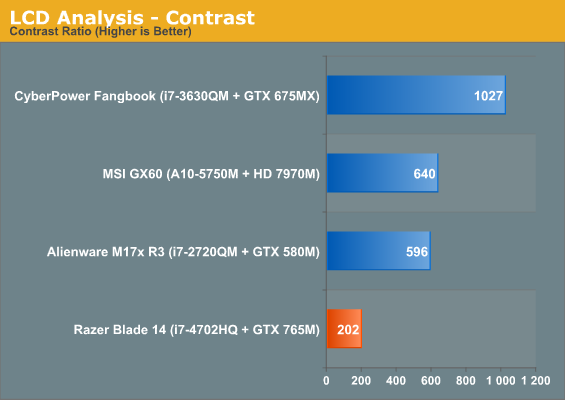
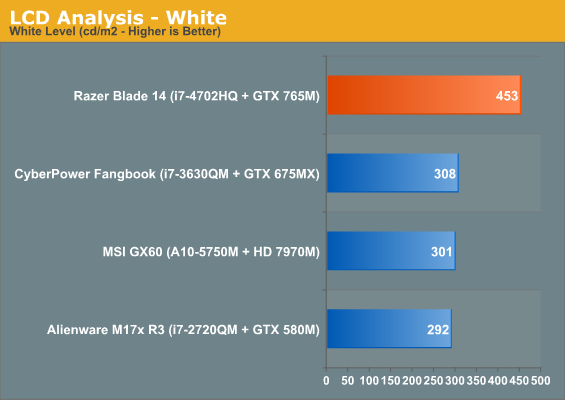
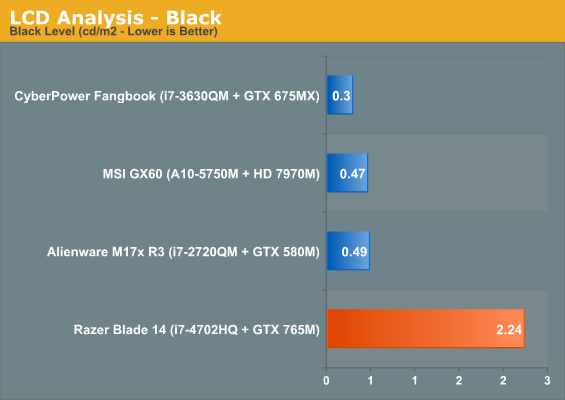
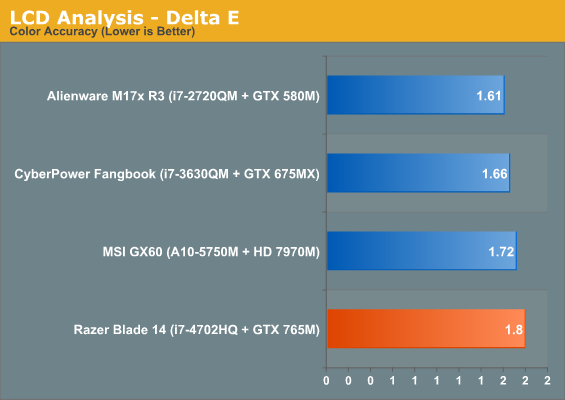
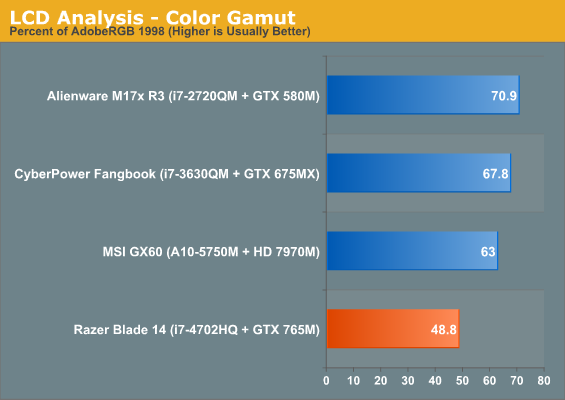
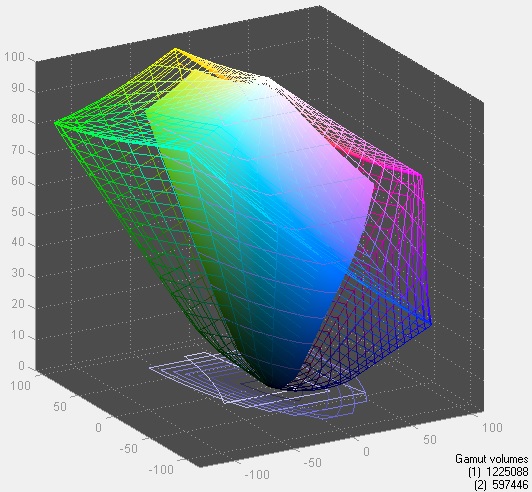
The Razer Blade 14-inch may be enjoying a 1600x900 resolution that's perfect for the gaming hardware included within, but the panel itself is atrocious. Razer was able to jack up the brightness to a respectable 453 nits, but it's a linear boost: the black level is a heinous 2.24 nits. There's just no excuse for this; Lenovo was able to get a 14", 1600x900 panel in their X1 Carbon that walks all over the Blade's. And Alienware is offering a 1080p IPS panel on their Alienware 14, a notebook that may be thicker but offers the same GPU, an optical drive, and a faster CPU. I was stunned by the Blade's beautiful design, and I was equally stunned by its dire screen quality, which suffers from the same nasty "no correct viewing angle" problem that cheap TN panels typically do.
Battery Life
It's hard to generate much enthusiasm for the Razer Blade 14-inch after discovering how poor the display quality on it is, but the flipside is that the battery life on it is pretty impressive. Razer was able to cram a 70Wh battery into the Blade, and leveraging the 37W quad-core and NVIDIA's Optimus allows them to eke out a healthy amount of mobility.

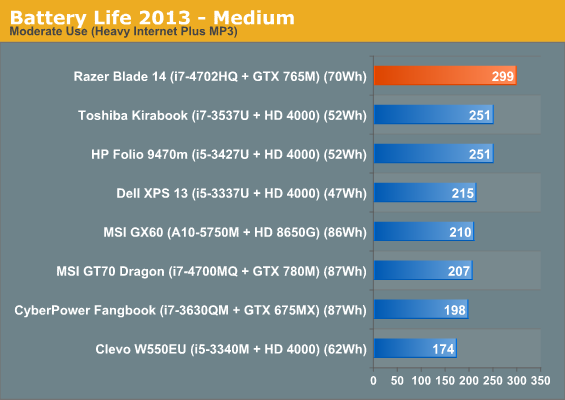
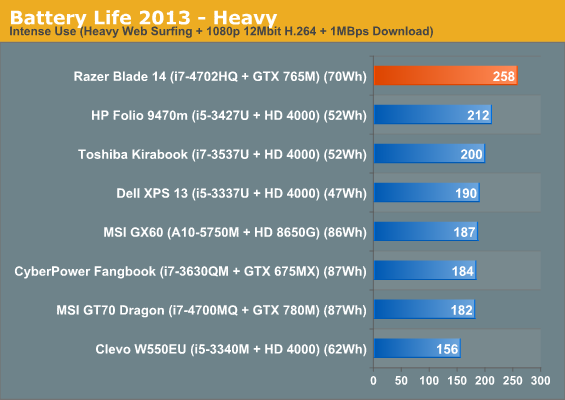
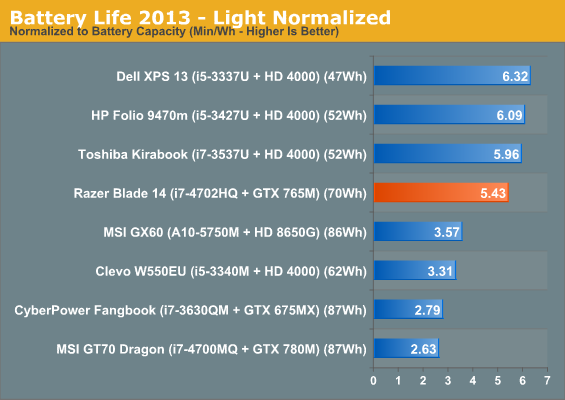

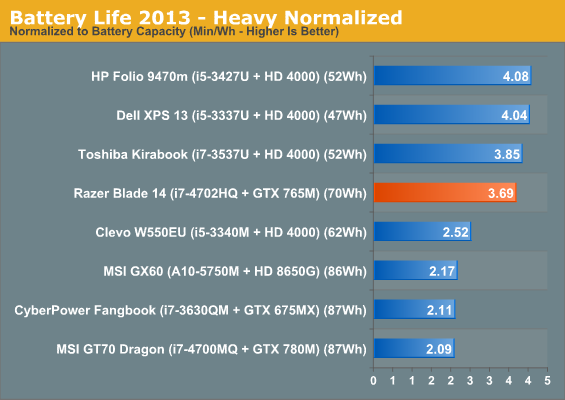
This is, without a doubt, a gaming ultrabook. Normalized power consumption is practically in line with full-on ultrabooks from the last generation sporting ULV processors, but Razer is able to do it with a full quad-core CPU and a beefy GPU (that turns off when not in use, naturally).
Heat and Noise
Razer was able to handle the balancing act of heat, noise, and chassis bulk with remarkable skill. I'm not sure they hit the absolute sweet spot, but they're awfully close to it. Fan noise is sub-40dB under load, which is actually pretty excellent for a gaming notebook. They're definitely playing "Thermal Chicken" with the surface temperatures, but unless you mash your giant hand down on the keyboard or keep poking the hinge with your fingertip (where most of the heat is), you're not going to be too uncomfortable.

The CPU temperatures definitely get up there and Razer is pretty close to playing with fire here, but in practice I found the system was ultimately able to handle thermals fairly well. If anything I feel like Razer has some room to improve here; I think they could spin up the fan on the CPU without having too negative an impact on system noise. Heat density is going to be much higher in the i7-4702HQ than it is in the GTX 765M; the 765M has 2.54 billion transistors on a 28nm process, and a good chunk of those transistors have been shut off. Meanwhile the i7-4702HQ 1.4 billion transistors on a 22nm process, and that's ignoring the marginal heat that's going to be produced by the on-package chipset.
I think there's still a little room for improvement here, and I'm never happy to see CPU core temperatures in the 90s, but it's not hitting throttling temperatures. Just remember that this notebook must take cool air in from the bottom. Other ultrabooks I'm a bit more critical of when they have bottom-intake cooling systems, but the Blade is handling 100W+ of silicon.










108 Comments
View All Comments
robco - Tuesday, July 2, 2013 - link
If they're going to crib from Apple, they need to go all the way. I don't want to hear any criticism about how Apple lacks ports or requires adapters. Not even ac wireless? With a rMBP, I could use a gig-E network adapter. My other primary concern is the intake vents on the bottom, since I do often use my laptop in my lap.I agree that this laptop has a lot going for it. But the display is very important. I don't see why they went cheap. Granted, Razer may not have Apple's R&D resources, but they don't have to write their own OS either.
Check101 - Tuesday, July 2, 2013 - link
Ah, thank you for the clarification. This confirms my thoughts... The notebook manages heat by pushing the heat away from the user, and it is slim, powerful, sturdy, and has a large battery. Now, some hard numbers show that this screen is terrible for this price-point. I was very curious about an upcoming review ever since Razer CEO posted a review of the 14 inch Blade on his Facebook page arguing that the screen was just fine, but that was a very quick review that glossed over important details. Now we know... Razer needs another iteration of this notebook...arthur449 - Tuesday, July 2, 2013 - link
Great review, Dustin. I enjoyed your attention to detail about the notebook's hot spots and remarks about the usability of the keyboard. You're also spot-on about Razer hitting the sweet spot in terms of notebook gaming hardware.While the screen is hilariously bad, how're its response times? It seems completely odd to me that they would've neglected this aspect of the overall package so badly. Maybe they sacrificed viewing angles, contrast, and color quality in favor of a bright twitchy TN panel gamers on-the-go would appreciate in poorly lit areas? I'm assuming it's not a 120Hz panel, but does it have any notable ghosting?
dwade123 - Tuesday, July 2, 2013 - link
It already struggles with the latest console ports. Next-gen ones are gonna make this an obsolete device.Silma - Tuesday, July 2, 2013 - link
It looks nice enough but unfortunately it follows the tradition of too many notebook makers of marrying a decent/good cpu/gpu pair with as many crappy parts as possible. Yet again, as for the Carbon X1, an indecent super baSilma - Tuesday, July 2, 2013 - link
super bad super low res screen.This, combined with no Ethernet network, and the wariness with Razer's lack of quality control that came with the purchases of too many premium mouses that won't work more than a few months at the most, will make it easy for to admire the notebook's aesthetics
from afar and buy something else, probably the Asus Infinity or the Samsung 9+ if they ever step out of vaporware.
SpartanJet - Tuesday, July 2, 2013 - link
Will you be reviewing the Razer Blade Pro this time around?wdfmph - Tuesday, July 2, 2013 - link
Last time I said gaming laptop does not make sense and lots of people shoot me. See it yourself. It just has to drop the ball here or there no matter how expensive they could be. Last time is the stupid single fan design in the MSI laptop, this time is the miserable screen.In addition, I think reliability of RAZER products questionable.
Winterblade - Tuesday, July 2, 2013 - link
Great review... hopefully the next version will correct the display quality, I'm perfectly fine with the resolution but if indeed windows 8.1 can fix the way windows manages high-density displays then I would definetly want a more dense display.Also, please Razer add a gigabit ethernet port or at least bundle the next generation blade with an adapter, this is a gaming machine, not a god-damn tablet.
I'm all in for a truly portable gaming machine, and at this very moment I consider this the very best option in that regard (NO, I will not carry more than 2Kg half-way trough the world, nobody should :P), that being said, with 2 horrible faults (display & ethernet) I just can't justify my self buying the blade, fix at least one of these and count me onboard for Gen2 Blade 14.
Roland00Address - Tuesday, July 2, 2013 - link
Dustin before you send back the Razer or resell it can you by chance test the integrated graphics for the intel hd4600. We got benchmarks for the desktop 4600 (but that has a much higher tdp so it can always hit those boost clocks), and we saw how thermally limited the intel 5000 was compared to the intel 4400 with the macbook air and acer s7.It would be nice to know how the non ulv intel hd graphics will perform in mainstream notebooks, and how this will compare to trinity/richland.